Structural Evolution of Two-Phase Blends of Polycarbonate and PMMA by Simultaneous Biaxial Stretching
Abstract
1. Introduction
2. Materials and Methods
3. Results and Discussion
4. Conclusions
Author Contributions
Funding
Conflicts of Interest
References
- Mount, E.M., III. Biaxial stretched films for use in snack packaging. In Biaxial Stretching of Film: Principles and Applications; DeMeuse, M.T., Ed.; Woodhead Publishing: Oxford, UK, 2011; pp. 165–203. ISBN 978-1-84569-675-7. [Google Scholar]
- Breil, J. Biaxial Oriented film technology. In Film Processing Advances; Kanai, T., Campbell, G.A., Eds.; Hanser: Cincinnati, OH, USA, 2014; pp. 193–229. ISBN 978-1-56990-529-6. [Google Scholar]
- Kanai, T. Biaxially oriented tentering film. In Film Processing Advances; Kanai, T., Campbell, G.A., Eds.; Hanser: Cincinnati, OH, USA, 2014; pp. 231–261. ISBN 978-1-56990-529-6. [Google Scholar]
- Mascia, L.; Fekkai, Z.; Guerra, G.; Parravicini, L.; Auriemma, F. Effects of distortional components in biaxial stretching of poly(ethylene terephthalate) sheets on dimensional stability and structure. J. Mater. Sci. 1994, 29, 3151–3160. [Google Scholar] [CrossRef]
- Dinelli, F.; Assender, H.; Kirov, K.; Kolosov, O. Surface morphology and crystallinity of biaxially stretched PET films on the nanoscale. Polymer 2000, 41, 4285–4289. [Google Scholar] [CrossRef]
- Nie, H.Y.; Walzak, M.J.; McIntyre, N.S. Atomic force microscopy study of biaxially oriented polypropylene films. J. Mater. Eng. Perform. 2004, 13, 451–460. [Google Scholar] [CrossRef]
- Beake, B.D.; Leggett, G.J. Nanoindentation and nanoscratch testing of uniaxially and biaxially drawn poly (ethylene terephthalate) film. Polymer 2002, 43, 319–327. [Google Scholar] [CrossRef]
- Jariyasakoolroj, P.; Tashiro, K.; Wang, H.; Yamamoto, H.; Chinsirikul, W.; Kerddonfag, N.; Chirachanchai, S. Isotropically small crystalline lamellae induced by high biaxial-stretching rate as a key microstructure for super-tough polylactide film. Polymer 2015, 68, 234–245. [Google Scholar] [CrossRef]
- De Vries, A.; Bonnebat, C.; Beautemps, J. Uni-and biaxial orientation of polymer films and sheets. J. Polym. Sci. Polym. Symp. 1977, 58, 109–156. [Google Scholar] [CrossRef]
- Elias, M.; Machado, R.; Canevarolo, S. Thermal and dynamic-mechanical characterization of uni-and biaxially oriented polypropylene films. J. Therm. Anal. Calorim. 2000, 59, 143–155. [Google Scholar] [CrossRef]
- Marco, Y.; Chevalier, L.; Chaouche, M. WAXD study of induced crystallization and orientation in poly(ethylene terephthalate) during biaxial elongation. Polymer 2002, 43, 6569–6574. [Google Scholar] [CrossRef]
- Douillard, A.; Hardy, L.; Stevenson, I.; Boiteux, G.; Seytre, G.; Kazmierczak, T.; Galeski, A. Texture and morphology of biaxially stretched poly(ethylene naphthalene-2,6-dicarboxylate). J. Appl. Polym. Sci. 2003, 89, 2224–2232. [Google Scholar] [CrossRef]
- Ajji, A.; Zhang, X.; Elkoun, S. Biaxial orientation in HDPE films: Comparison of infrared spectroscopy, X-ray pole figures and birefringence techniques. Polymer 2005, 46, 3838–3846. [Google Scholar] [CrossRef]
- Ou, X.; Cakmak, M. Influence of biaxial stretching mode on the crystalline texture in polylactic acid films. Polymer 2008, 49, 5344–5352. [Google Scholar] [CrossRef]
- Ou, X.; Cakmak, M. Comparative study on development of structural hierarchy in constrained annealed simultaneous and sequential biaxially stretched polylactic acid films. Polymer 2010, 51, 783–792. [Google Scholar] [CrossRef]
- Hassan, M.; Cakmak, M. Mechano optical behavior of polyethylene terephthalate films during simultaneous biaxial stretching: Real time measurements with an instrumented system. Polymer 2013, 54, 6463–6470. [Google Scholar] [CrossRef]
- Hassan, M.K.; Cakmak, M. Mechanisms of structural organizational processes as revealed by real time mechano optical behavior of PET film during sequential biaxial stretching. Polymer 2014, 55, 5245–5254. [Google Scholar] [CrossRef]
- Horn, B.L.V.; Winter, H.H. Conoscopic measurement of birefringence and orientation in biaxially stretched polymer films and sheets. Macromolecules 2003, 36, 8513–8521. [Google Scholar] [CrossRef]
- Yoshida, S.; Ishii, K.; Kawamura, T.; Nitta, K.-H. Molecular orientation behavior of mesomorphic isotactic polypropylene under uniaxial and biaxial deformation. Polym. Eng. Sci. 2011, 51, 225–231. [Google Scholar] [CrossRef]
- Yoshida, S.; Sawada, T.; Kawamura, T.; Nitta, K.-H. Investigation of a rheo-optical method for determining the in-situ molecular orientation behavior in stretching films under biaxial deformation. Polym. Test. 2011, 30, 893–898. [Google Scholar] [CrossRef]
- Cole, K.; Daly, H.B.; Sanschagrin, B.; Nguyen, K.; Ajji, A. A new approach to the characterization of molecular orientation in uniaxially and biaxially oriented samples of poly (ethylene terephthalate). Polymer 1999, 40, 3505–3513. [Google Scholar] [CrossRef]
- Cole, K.C.; Depecker, C.; Jutigny, M.; Lefebvre, J.-M.; Krawczak, P. Biaxial deformation of polyamide-6: Assessment of orientation by means of infrared trichroism. Polym. Eng. Sci. 2004, 44, 231–240. [Google Scholar] [CrossRef]
- Nitta, K.-H.; Sawada, T.; Yoshida, S.; Kawamura, T. Three dimensional molecular orientation of isotactic polypropylene films under biaxial deformation at higher temperatures. Polymer 2015, 74, 30–37. [Google Scholar] [CrossRef]
- Bur, A.J.; Roth, S.C. Real-time monitoring of fluorescence anisotropy and temperature during processing of biaxially stretched polypropylene film. Polym. Eng. Sci. 2004, 44, 805–813. [Google Scholar] [CrossRef]
- Sweeney, J.; Spares, R.; Woodhead, M. A constitutive model for large multiaxial deformations of solid polypropylene at high temperature. Polym. Eng. Sci. 2009, 49, 1902–1908. [Google Scholar] [CrossRef]
- Buckley, C.P.; Lew, C.Y. Biaxial hot-drawing of poly(ethylene terephthalate): An experimental study spanning the processing range. Polymer 2011, 52, 1803–1810. [Google Scholar] [CrossRef]
- Tamura, S.; Kuramoto, I.; Kanai, T. The effect of molecular structure of polypropylene on stretchability for biaxially oriented film. Polym. Eng. Sci. 2012, 52, 1383–1393. [Google Scholar] [CrossRef]
- Lepers, J.-C.; Favis, B.; Kent, S. Interface-property relationships in biaxially stretched PP-PET blends. Polymer 2000, 41, 1937–1946. [Google Scholar] [CrossRef]
- Lin, Y.; Hiltner, A.; Baer, E. A new method for achieving nanoscale reinforcement of biaxially oriented polypropylene film. Polymer 2010, 51, 4218–4224. [Google Scholar] [CrossRef]
- Feng, J.; Zhang, G.; MacInnis, K.; Olah, A.; Baer, E. Formation of microporous membranes by biaxial orientation of compatibilized PP/nylon 6 blends. Polymer 2017, 123, 301–310. [Google Scholar] [CrossRef]
- Kim, J.; Cakmak, M.; Zhou, X. Effect of composition on orientation, optical and mechanical properties of bi-axially drawn PEN and PEN/PEI blend films. Polymer 1998, 39, 4225–4234. [Google Scholar] [CrossRef]
- Al-Itry, R.; Lamnawar, K.; Maazouz, A.; Billon, N.; Combeaud, C. Effect of the simultaneous biaxial stretching on the structural and mechanical properties of PLA, PBAT and their blends at rubbery state. Eur. Polym. J. 2015, 68, 288–301. [Google Scholar] [CrossRef]
- Chapleau, N.; Huneault, M.A.; Li, H. Biaxial orientation of polylactide/thermoplastic starch blends. Int. Polym. Process. 2007, 22, 402–409. [Google Scholar] [CrossRef]
- Tsunekawa, T.; Higashioji, T.; Hosokawa, H.; Kubota, A.; Ishizuka, I. Development and industrialization of a biaxially stretched nano-alloyed film. Polym. J. 2012, 44, 1170–1178. [Google Scholar] [CrossRef]
- Jéol, S.; Fenouillot, F.; Rousseau, A.; Masenelli-Varlot, K.; Gauthier, C.; Briois, J.-F. Drastic modification of the dispersion state of submicron silica during biaxial deformation of poly(ethylene terephthalate). Macromolecules 2007, 40, 3229–3237. [Google Scholar] [CrossRef]
- Abu-Zurayk, R.; Harkin-Jones, E.; McNally, T.; Menary, G.; Martin, P.; Armstrong, C.; McAfee, M. Structure-property relationships in biaxially deformed polypropylene nanocomposites. Compos. Sci. Technol. 2010, 70, 1353–1359. [Google Scholar] [CrossRef]
- Tabatabaei, S.H.; Ajji, A. Crystal structure and orientation of uniaxially and biaxially oriented PLA and PP nanoclay composite films. J. Appl. Polym. Sci. 2012, 124, 4854–4863. [Google Scholar] [CrossRef]
- Katsamberis, D.; Browall, K.; Iacovangelo, C.; Neumann, M.; Morgner, H. Highly durable coatings for automotive polycarbonate glazing. Prog. Org. Coat. 1998, 34, 130–134. [Google Scholar] [CrossRef]
- Wu, L.Y.; Chwa, E.; Chen, Z.; Zeng, X. A study towards improving mechanical properties of sol-gel coatings for polycarbonate. Thin Solid Films 2008, 516, 1056–1062. [Google Scholar] [CrossRef]
- Fabbri, P.; Messori, M.; Toselli, M.; Veronesi, P.; Rocha, J.; Pilati, F. Enhancing the scratch resistance of polycarbonate with poly(ethylene oxide)-silica hybrid coatings. Adv. Polym. Technol. 2009, 27, 117–126. [Google Scholar] [CrossRef]
- Taguchi, T.; Saito, H. Effects of plasticization and hydrostatic pressure on tensile properties of PMMA under compressed carbon dioxide and nitrogen. J. Appl. Polym. Sci. 2016, 133, 43431. [Google Scholar] [CrossRef]
- Taguchi, T.; Hatakeyama, T.; Miike, R.; Saito, H. Evolution of filament-shaped porous structure in polycarbonate by stretching under carbon dioxide. Polymers 2018, 10, 148. [Google Scholar] [CrossRef]
- Taguchi, T.; Miike, R.; Hatakeyama, T.; Saito, H. Ductile-to-brittle transition behavior of low molecular weight polycarbonate under carbon dioxide. Polym. Eng. Sci. 2018, 58, 683–690. [Google Scholar] [CrossRef]
- Anshul, F.; Venkitanarayanan, P.; Sumit, B. Mechanics of dynamic fracture in notched polycarbonate. J. Mech. Phys. Solids 2015, 77, 43–60. [Google Scholar]
- Sako, T.; Ito, A.; Yamaguchi, M. Surface segregation during injection molding of polycarbonate/poly(methyl methacrylate) blend. J. Polym. Res. 2017, 24, 89. [Google Scholar] [CrossRef]
- Onuki, A. Effects of shear flow and viscosity difference on phase separation. Int. J. Thermophys. 1995, 16, 381–390. [Google Scholar] [CrossRef]
- Onuki, A. Phase transitions of fluids in shear flow. J. Phys. Condens. Matter 1997, 9, 6119. [Google Scholar] [CrossRef]
- Viville, P.; Biscarini, F.; Bredas, J.; Lazzaroni, R. Scaling aspects of the kinetics of thermally induced phase separation in bisphenol a polycarbonate/poly(methyl methacrylate) blends. J. Phys. Chem. B 2001, 105, 7499–7507. [Google Scholar] [CrossRef]
- An, N.; Yang, Y.; Dong, L. Suppression of phase separation in PC/PMMA blend film by thermoset oligomer. Macromolecules 2007, 40, 306–311. [Google Scholar] [CrossRef]
- Delaby, I.; Ernst, B.; Froelich, D.; Muller, R. Droplet deformation in immiscible polymer blends during transient uniaxial elongational flow. Polym. Eng. Sci. 1996, 36, 1627–1635. [Google Scholar] [CrossRef]
- Migler, K.; Hobbie, E.K.; Qiao, F. In line study of droplet deformation in polymer blends in channel flow. Polym. Eng. Sci. 1999, 39, 2282–2291. [Google Scholar] [CrossRef]
- Mechbal, N.; Bousmina, M. Uniaxial deformation and relaxation of polymer blends: Relationship between flow and morphology development. Rheol. Acta 2004, 43, 119–126. [Google Scholar] [CrossRef]
- Chapleau, N.; Favis, B. Droplet/fibre transitions in immiscible polymer blends generated during melt processing. J. Mater. Sci. 1995, 30, 142–150. [Google Scholar] [CrossRef]
- Hong, Z.; Shaw, M.T.; Weiss, R. Effect of shear flow on the morphology and phase behavior of a near-critical SAN/PMMA blend. Macromolecules 1998, 31, 6211–6216. [Google Scholar] [CrossRef]
- Lee, J.K.; Han, C.D. Evolution of polymer blend morphology during compounding in a twin-screw extruder. Polymer 2000, 41, 1799–1815. [Google Scholar] [CrossRef]
- Tucker, C.L., III; Moldenaers, P. Microstructural evolution in polymer blends. Annu. Rev. Fluid Mech. 2002, 34, 177–210. [Google Scholar] [CrossRef]
- Zou, F.; Dong, X.; Lin, D.; Liu, W.; Wang, D.; Han, C.C. Morphological and rheological responses to the transient and steady shear flow for a phase-separated polybutadiene/polyisoprene blend. Polymer 2012, 53, 4818–4826. [Google Scholar] [CrossRef]
- Mitchell, G.; Windle, A. The effect of annealing on the local structure of glassy polycarbonate. Colloid Polym. Sci. 1985, 263, 280–285. [Google Scholar] [CrossRef]
- Yu, P.; Yao, X.H.; Han, Q.; Zang, S.G.; Gu, Y.B. A visco-elastoplastic constitutive model for large deformation response of polycarbonate over a wide range of strain rates and temperatures. Polymer 2014, 55, 6577–6593. [Google Scholar] [CrossRef]
- Mani, S.; Malone, M.F.; Winter, H.H. Shear-induced demixing in a polystyrene/poly(vinyl methyl ether) blend: In-situ fluorescence and rheometry. Macromolecules 1992, 25, 5671–5676. [Google Scholar] [CrossRef]
- Lei, Q.-L.; Feng, J.-W.; Ding, H.-M.; Ren, C.-L.; Ma, Y.-Q. Modeling stretching-induced immiscibility in nonmonodisperse polymer systems. ACS Macro Lett. 2015, 4, 1033–1038. [Google Scholar] [CrossRef]
- Ratke, L.; Voorhees, P.W. Growth and Coarsening: Ostwald Ripening in Material Processing; Springer: Berlin, Germany, 2002; ISBN 978-3-540-42563-2. [Google Scholar]
- Kurkcu, P.; Andena, L.; Pavan, A. An experimental investigation of the scratch behaviour of polymers: 1. Influence of rate-dependent bulk mechanical properties. Wear 2012, 290–291, 86–93. [Google Scholar] [CrossRef]
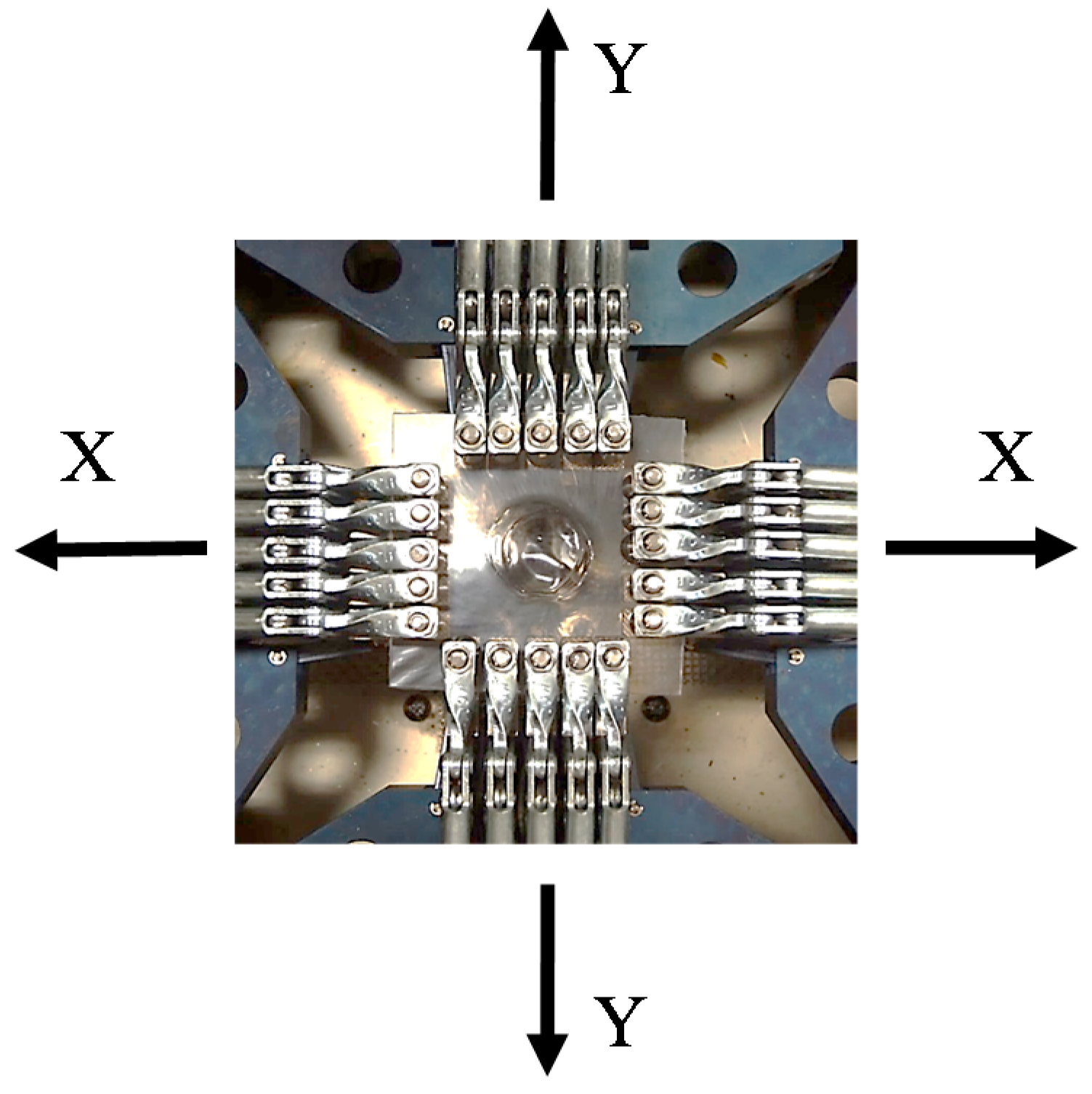
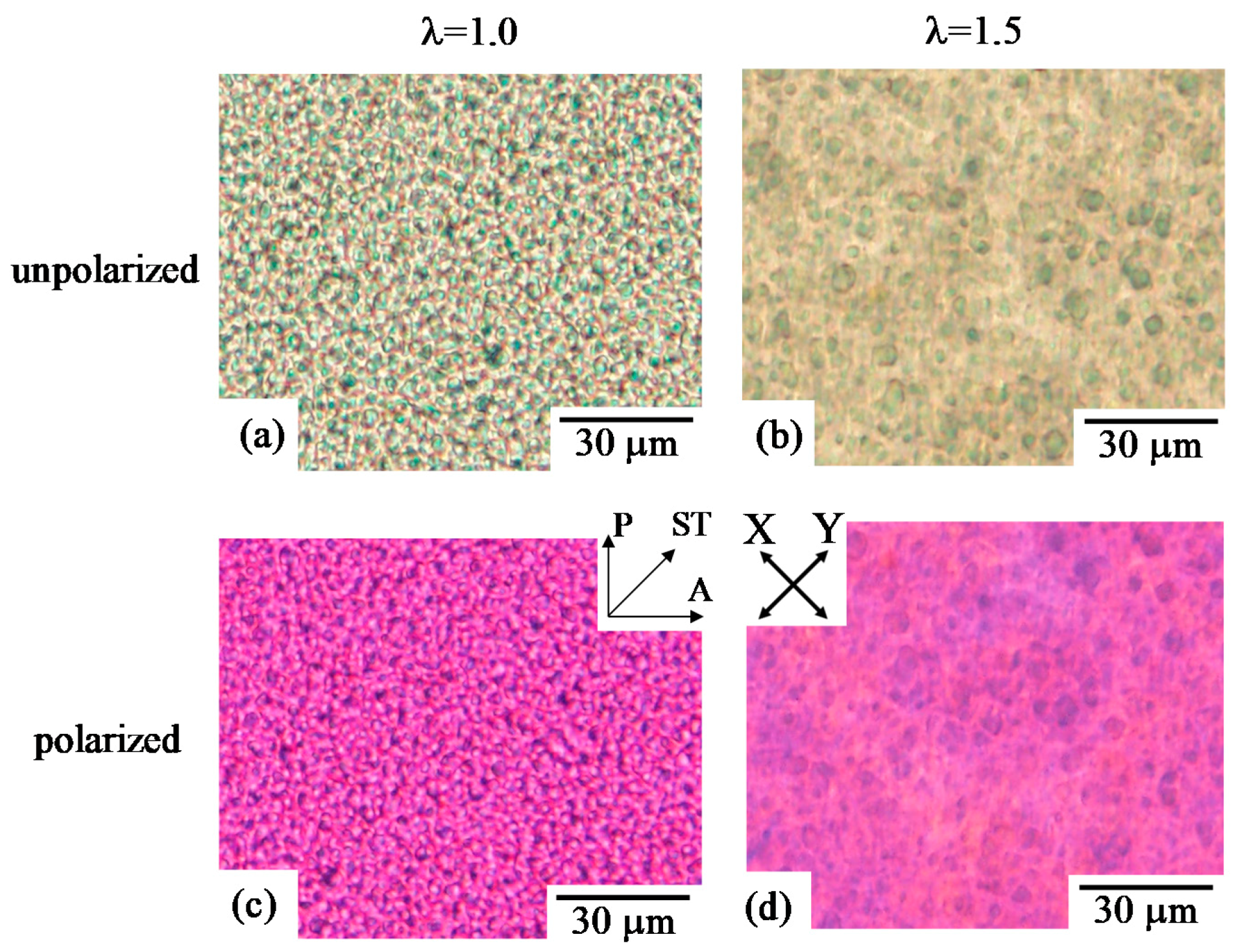
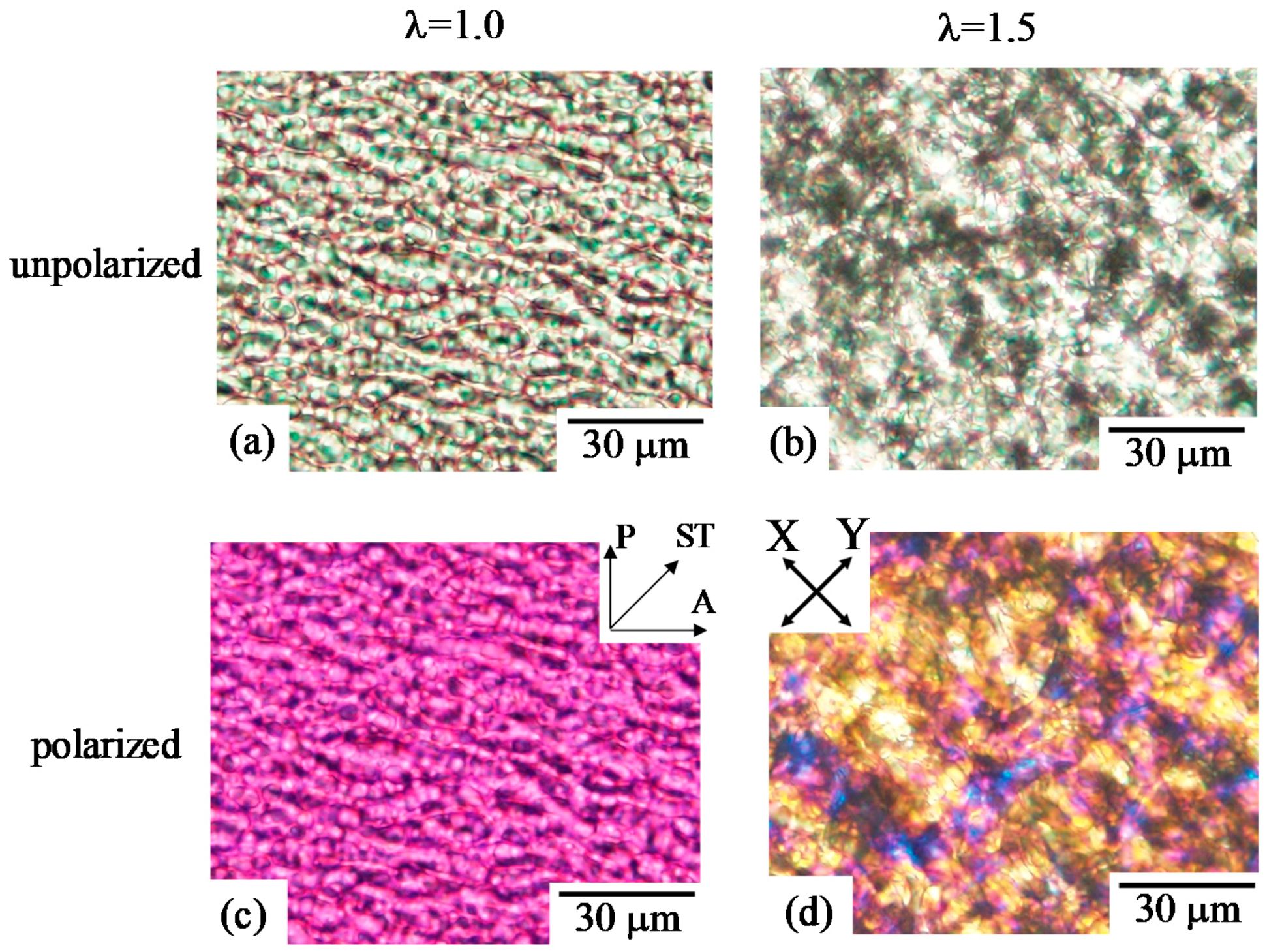
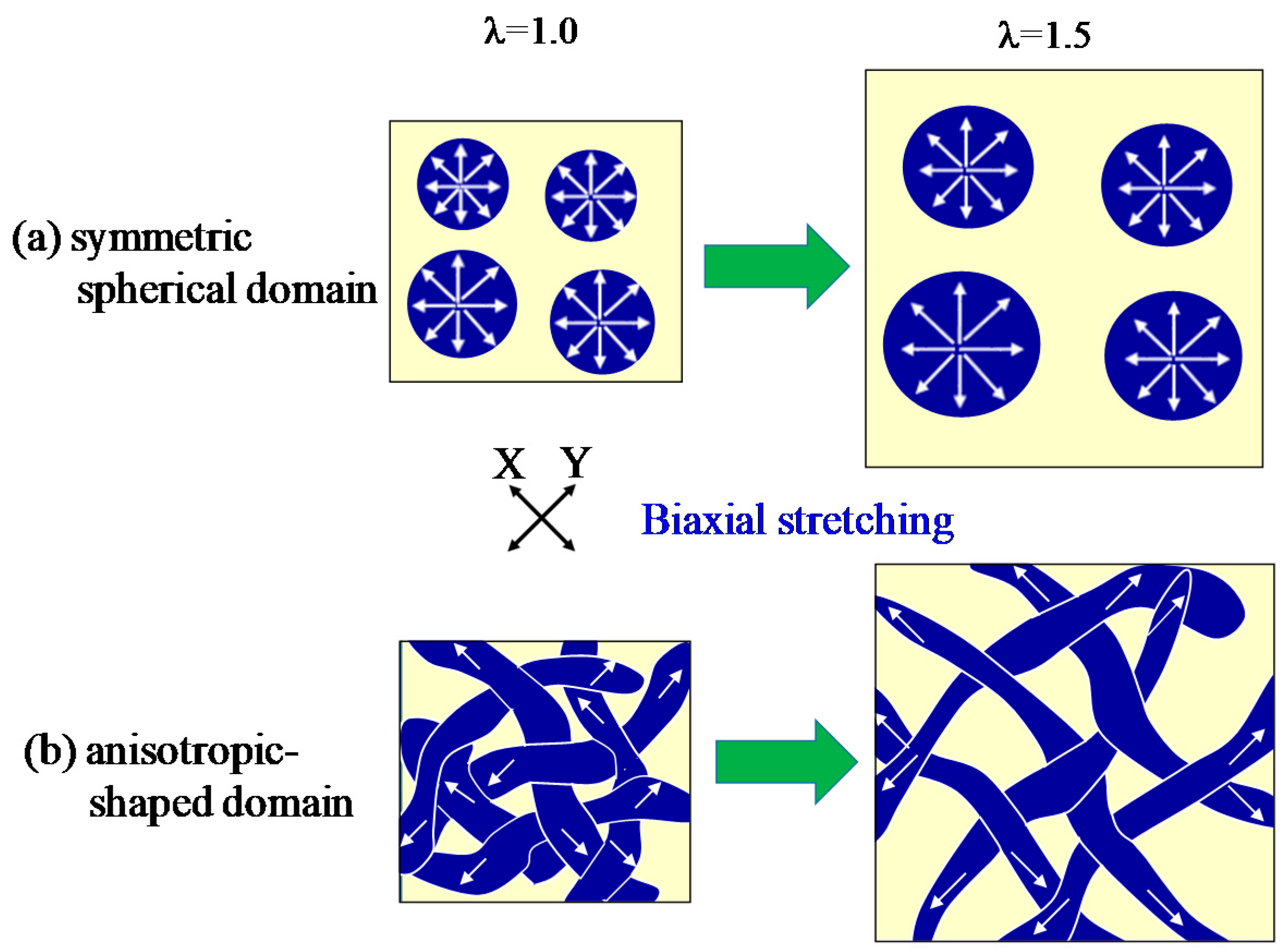
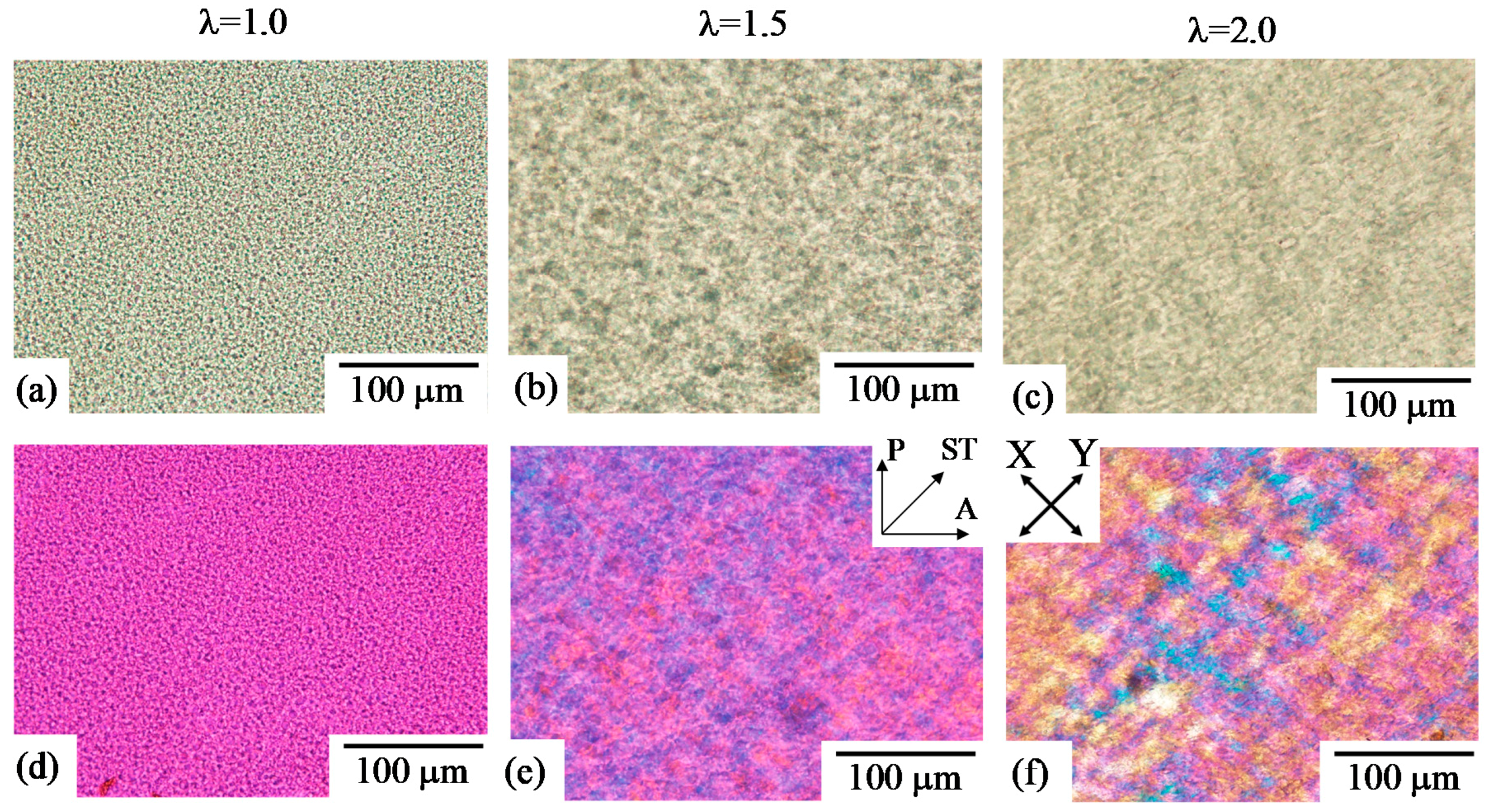
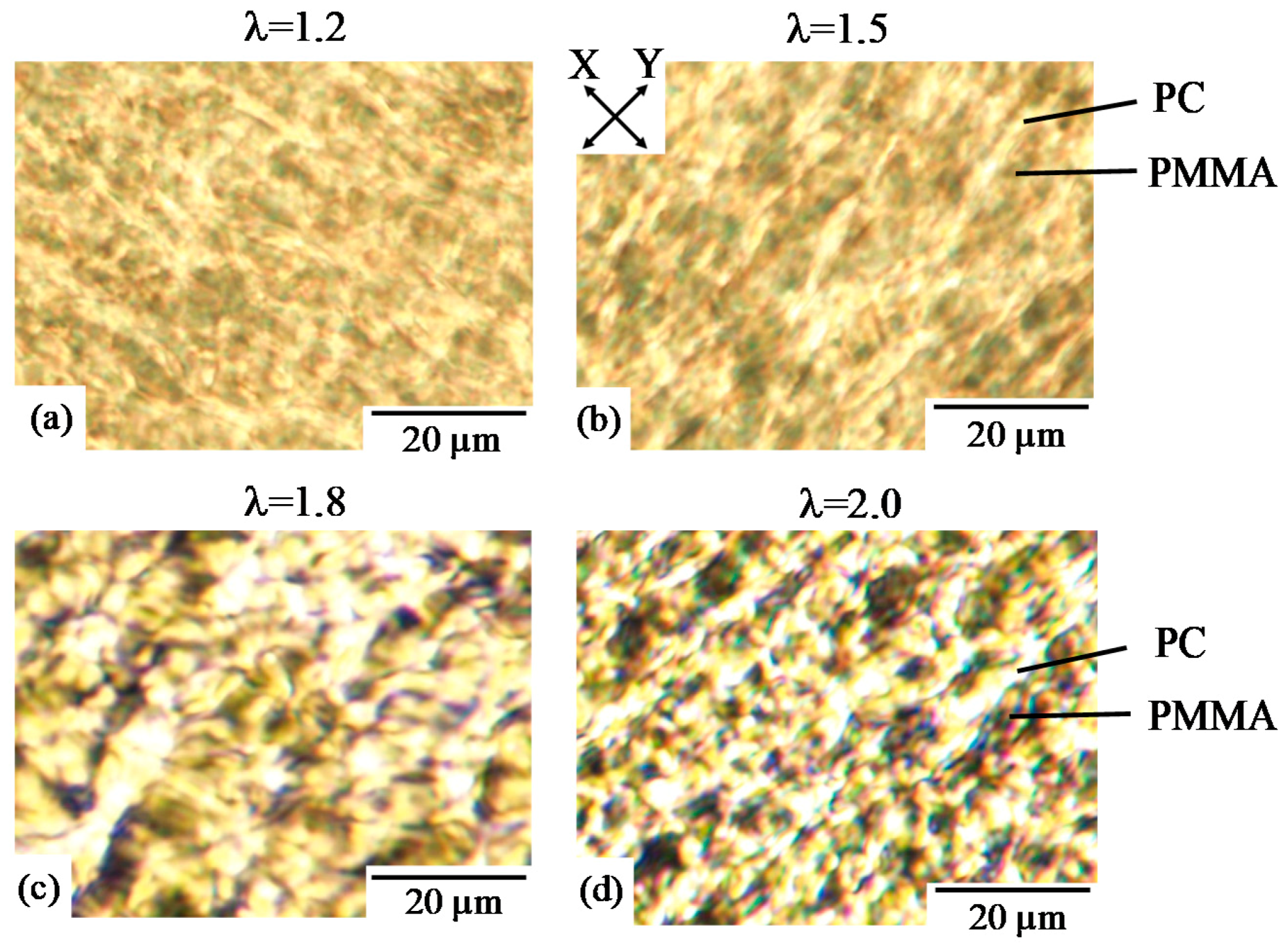
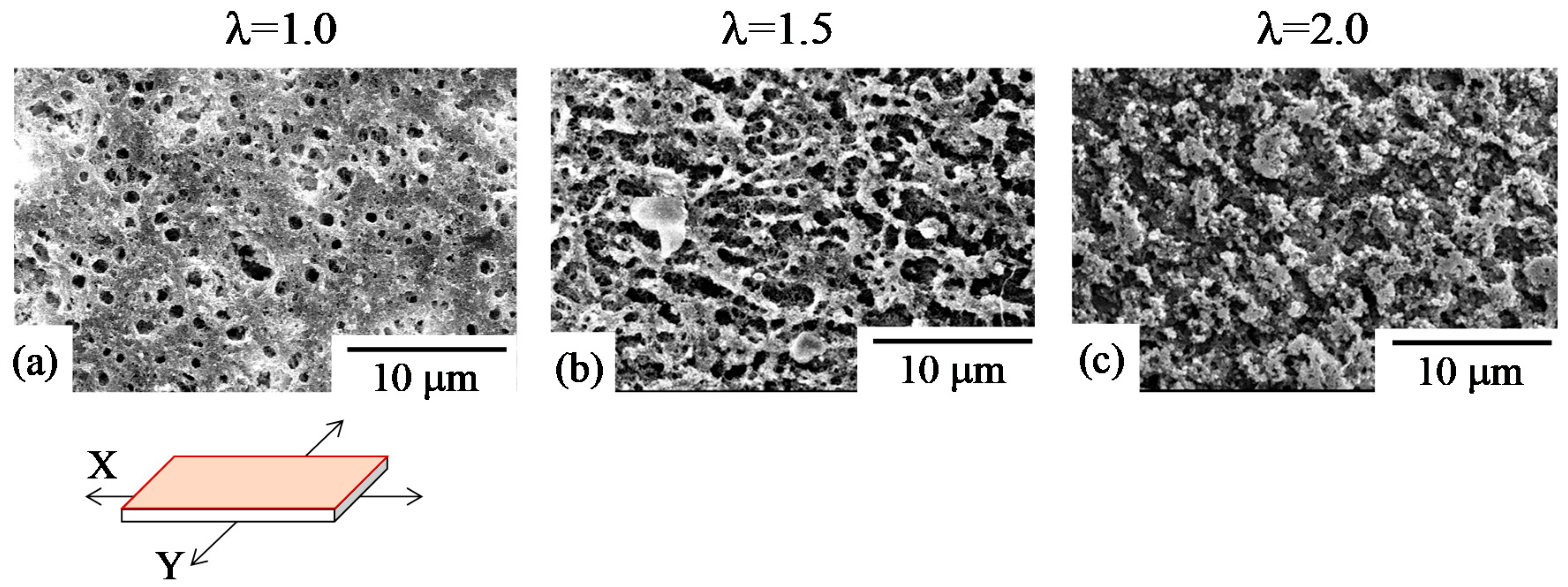
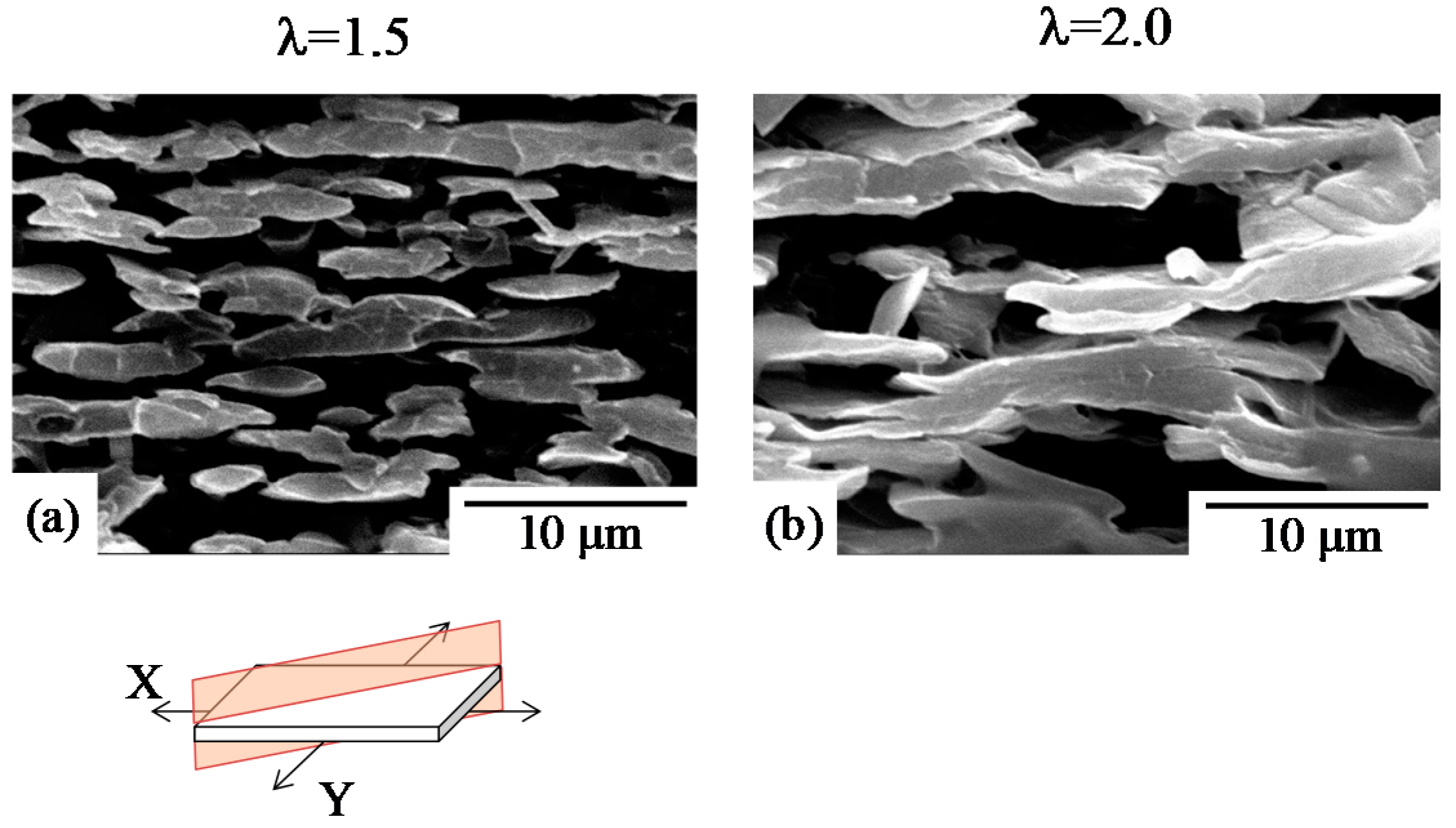
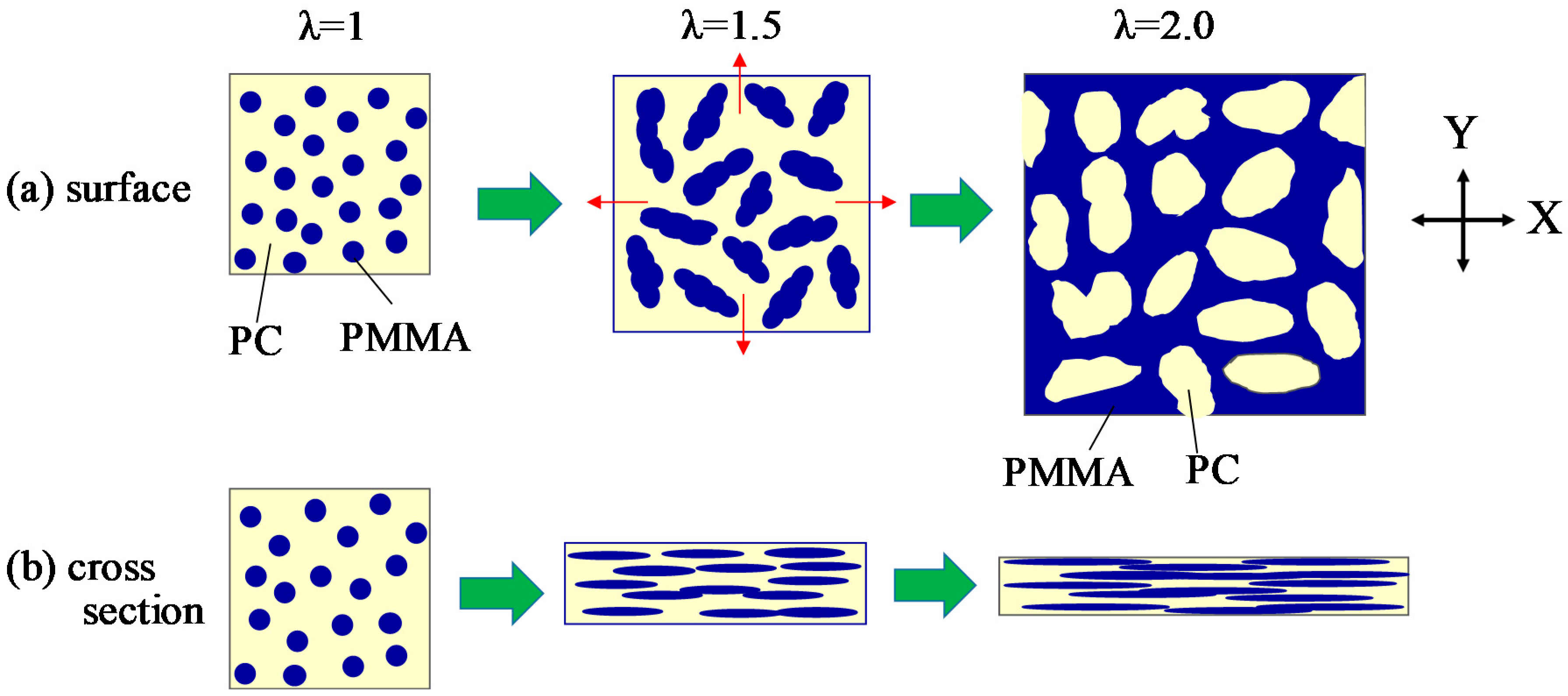
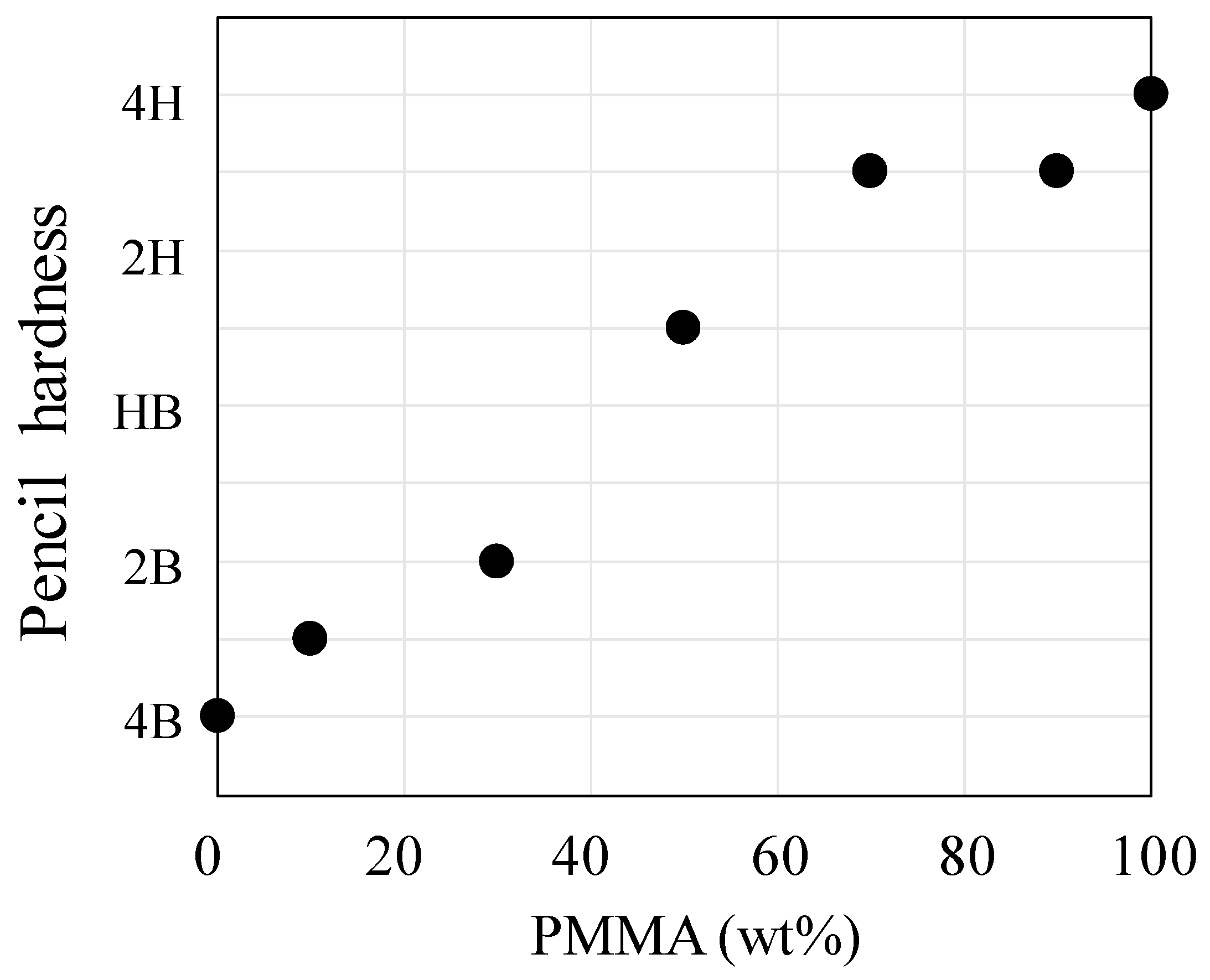
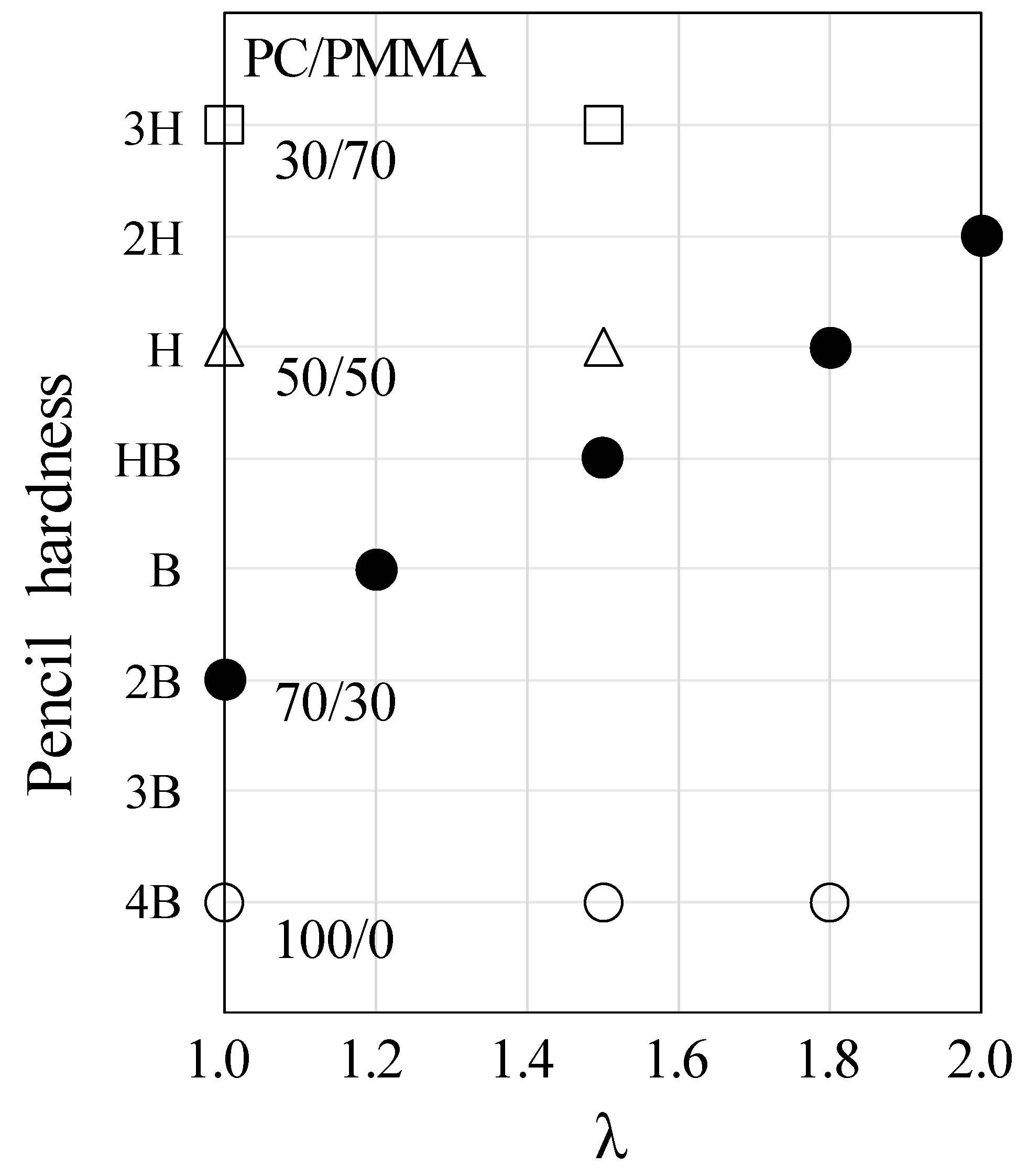
© 2018 by the authors. Licensee MDPI, Basel, Switzerland. This article is an open access article distributed under the terms and conditions of the Creative Commons Attribution (CC BY) license (http://creativecommons.org/licenses/by/4.0/).
Share and Cite
Kobayashi, T.; Saito, H. Structural Evolution of Two-Phase Blends of Polycarbonate and PMMA by Simultaneous Biaxial Stretching. Polymers 2018, 10, 950. https://doi.org/10.3390/polym10090950
Kobayashi T, Saito H. Structural Evolution of Two-Phase Blends of Polycarbonate and PMMA by Simultaneous Biaxial Stretching. Polymers. 2018; 10(9):950. https://doi.org/10.3390/polym10090950
Chicago/Turabian StyleKobayashi, Takumi, and Hiromu Saito. 2018. "Structural Evolution of Two-Phase Blends of Polycarbonate and PMMA by Simultaneous Biaxial Stretching" Polymers 10, no. 9: 950. https://doi.org/10.3390/polym10090950
APA StyleKobayashi, T., & Saito, H. (2018). Structural Evolution of Two-Phase Blends of Polycarbonate and PMMA by Simultaneous Biaxial Stretching. Polymers, 10(9), 950. https://doi.org/10.3390/polym10090950




